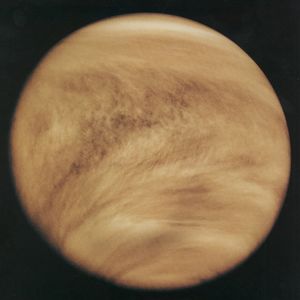Venus
Contents
Explanation
Venus is the second planet from the Sun and is the hottest planet in the solar system. It is similar to Earth in size of about 6052 km in radius, with an iron core of 3200 km in radius. The planet is highly volcanic due to the thin crust and the interior heat. Venus lacks seasons as the axis of the planet has only a 3° tilt. The temperature reaches as high as 744 K on the surface of the planet due to the heat trapped in the dense atmosphere and by the runaway greenhouse effect. It also makes the planet visible from Earth even during the day, as the thick and toxic atmospheric clouds reflect most sunlight. In fact, it is bright enough to cast shadows at night. Venus is the third brightest object in the sky when seen from Earth.
Venus takes about 243 Earth days for Venus to rotate and about 225 Earth days to revolve around the Sun in a nearly perfect circular orbit. The planet's rotation is the slowest of all planets, and it rotates in a clockwise direction compared to the other planets in the solar system. The other planet that rotates this way is Uranus. Due to this retrograde rotation, the day-night cycle happens every 117 Earth days. The slow rotation is the reason why Venus has a very weak magnetosphere.
Frequently Asked Questions
Is there water on Venus?
Studies of the previous data and the results from ESA's Venus Express missions from the Venus had shown that about 0.002% of water vapour might be retained in the upper layers of the atmosphere in the clouds. It is believed that water might have formed on Venus through the impacts of comets and asteroids and should have evaporated completely due to the runaway greenhouse effect. It also explains the hydrogen atoms being stripped away from the planet's atmosphere.
How runaway greenhouse effect makes Venus hotter than Mercury?
Though Mercury is closer to the Sun, it doesn't have an atmosphere to retain all the heat. In contrast, Venus has a dense atmosphere that retains all the heat on the planet. Besides that, due to the volcanic activities the Venusian atmosphere has more carbon dioxide in it. It is believed that during the formation of the planet, Venus might have had oceans, which later boiled and evaporated due to the high temperature.[1] The water vapour should have photodissociated into hydrogen and oxygen. And the oxygen should have oxidized surface minerals, releasing carbon dioxide, a greenhouse gas into Venus's atmosphere. The increase in the temperature due to the greenhouse effect would then evaporate more water into water vapour, another greenhouse gas, and would have enabled a positive feedback on the carbon dioxide-rich atmosphere to form a runaway greenhouse effect that makes Venus, the hottest planet in the solar system.
References
- ↑ Ingersoll, Andrew P. "The Runaway Greenhouse: A History Of Water On Venus". Journal of the Atmospheric Sciences 26.6 (1969): 1191-1198. Web. 12 Jan. 2017.

